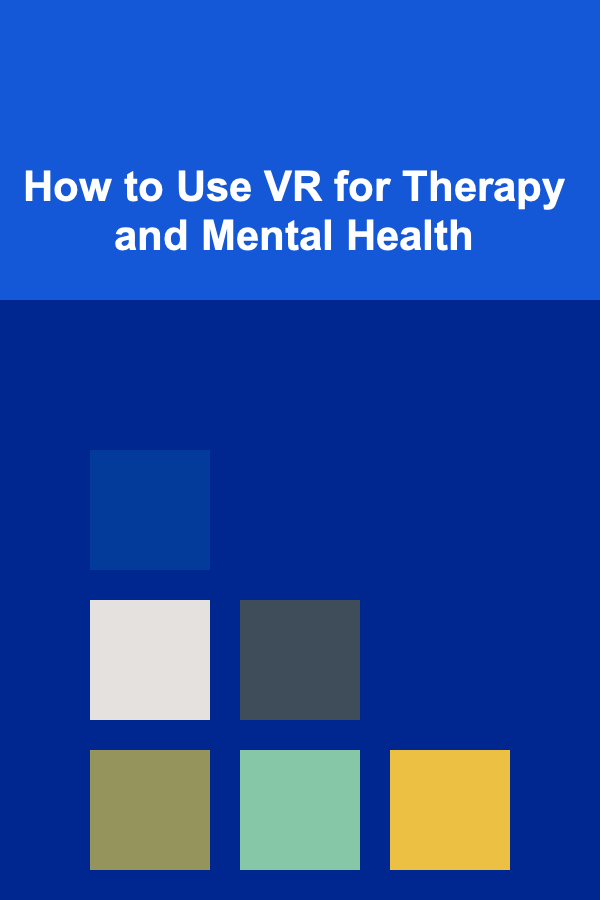
How to Use VR for Therapy and Mental Health
ebook include PDF & Audio bundle (Micro Guide)
$12.99$10.99
Limited Time Offer! Order within the next:

Virtual Reality (VR) has evolved significantly in recent years, expanding its applications from entertainment and gaming to fields like education, healthcare, and therapy. The integration of VR into mental health care is a promising frontier, providing new approaches to treating psychological conditions and enhancing mental well-being. This article explores how VR is being used for therapy and mental health, detailing its potential benefits, challenges, and future directions.
The Rise of Virtual Reality in Mental Health
The concept of using virtual environments for therapy is not new, but advances in VR technology have made it more feasible and effective. In the past, mental health treatments were often limited to traditional methods like talk therapy and medication. However, VR offers a unique tool to create immersive, controlled, and customizable environments that can help patients confront their issues in a safe and monitored way.
VR therapy works by immersing the patient in a virtual world where they can engage in various therapeutic exercises. This virtual world can be designed to mimic real-life scenarios, such as public speaking or social interactions, or it can be a completely abstract, therapeutic environment aimed at relaxation and mindfulness. The possibilities are vast, and the applications continue to expand as the technology improves.
The Science Behind VR Therapy
The use of VR in therapy is rooted in psychological theories and principles such as exposure therapy , cognitive-behavioral therapy (CBT) , and mindfulness techniques. These therapeutic approaches aim to help individuals confront their fears, change negative thought patterns, and practice mindfulness in a controlled, supportive environment.
Exposure Therapy
Exposure therapy is a psychological treatment that helps people confront and reduce their fear and anxiety toward a specific object, situation, or event. Traditionally, exposure therapy involves gradual, real-world exposure to the feared stimulus. VR enhances this approach by providing a safe, controlled environment where patients can face their fears at their own pace. For example, a person with social anxiety might practice speaking in front of a virtual audience, or someone with post-traumatic stress disorder (PTSD) may confront traumatic memories in a controlled, virtual environment.
Cognitive-Behavioral Therapy (CBT)
CBT is one of the most widely used therapies for treating conditions like depression, anxiety, and stress. It helps individuals identify and change negative thought patterns that affect their emotions and behavior. VR can facilitate CBT by providing immersive scenarios where patients can practice cognitive restructuring techniques. For instance, VR can simulate situations that trigger anxiety, allowing individuals to learn how to react more adaptively in real-time.
Mindfulness and Relaxation
Mindfulness-based interventions aim to help individuals focus on the present moment, reduce stress, and cultivate a sense of peace. VR can create peaceful, calming environments such as nature scenes or tranquil beaches, which can help patients relax and practice mindfulness. By immersing patients in these environments, VR enhances the mindfulness experience and promotes emotional regulation.
Applications of VR in Mental Health Treatment
1. Treatment of Anxiety Disorders
Anxiety disorders, including generalized anxiety disorder (GAD), social anxiety, and phobias, are among the most common mental health conditions globally. Traditional treatments often include a combination of medication and therapy. VR is increasingly being used as a tool for exposure therapy to treat anxiety-related conditions.
In VR exposure therapy, patients can face simulated situations that trigger anxiety in a safe and controlled way. For example:
- Phobias: VR can simulate environments that trigger phobias, such as heights, spiders, or flying, enabling patients to gradually confront their fears in a low-risk setting.
- Social Anxiety: For individuals with social anxiety, VR can create virtual social interactions, such as speaking in public or attending a party, to help patients practice social skills and manage their anxiety.
Studies have shown that VR exposure therapy can be as effective, if not more, than traditional face-to-face therapy. Patients who may find it difficult to engage in real-world exposure exercises can benefit from VR's ability to create controlled, repeatable, and customizable environments.
2. PTSD and Trauma Recovery
Post-traumatic stress disorder (PTSD) affects individuals who have experienced severe trauma, such as combat, accidents, or abuse. Traditional PTSD treatments, including cognitive processing therapy (CPT) and eye movement desensitization and reprocessing (EMDR), are effective, but they can be emotionally taxing and require significant time.
VR therapy offers a new method of virtual reality exposure therapy (VRET), which allows individuals to confront and process traumatic memories in a safe space. The therapist can control the environment and exposure levels, tailoring the experience to the patient's comfort level. For example:
- Re-exposure to Trauma: A veteran with PTSD might be exposed to virtual warzone environments to gradually desensitize them to their trauma.
- Controlled Settings: Patients can revisit traumatic events through VR in a manner that allows for emotional processing, with support from the therapist.
VRET has shown promising results in reducing PTSD symptoms, with some studies indicating that VR therapy can significantly reduce flashbacks, anxiety, and emotional numbness associated with PTSD.
3. Treatment of Depression
Depression is another prevalent mental health condition that can benefit from VR therapy. Traditional treatments for depression, including CBT and medication, may not work for everyone, and some patients struggle with adherence to treatment. VR can enhance traditional therapy methods by creating interactive, engaging experiences that encourage patients to practice coping strategies.
In the context of depression:
- Cognitive-Behavioral VR: VR can simulate real-world situations where patients can practice cognitive restructuring, such as challenging negative thoughts or improving problem-solving skills.
- Mindfulness VR: By immersing patients in peaceful, calming environments, VR can encourage mindfulness and relaxation techniques, which are helpful for individuals with depression.
VR's immersive nature can make therapeutic exercises feel more engaging and impactful, which may increase treatment adherence and effectiveness for individuals who struggle with depression.
4. Pain Management
In addition to treating mental health conditions directly, VR is also being explored as a tool for managing physical pain. Chronic pain is often linked to mental health issues, such as depression and anxiety, and VR can be used to distract individuals from their pain or teach pain management techniques.
For example:
- Distraction Therapy: VR games or simulations can engage the patient in an immersive experience, distracting them from their pain during medical procedures or recovery.
- Relaxation and Mindfulness: VR can guide patients through relaxation exercises, helping them manage pain by promoting calmness and reducing stress.
Several studies have shown that VR is effective in reducing the perception of pain and improving the overall quality of life for patients with chronic conditions, including fibromyalgia and cancer.
5. Rehabilitation and Cognitive Therapy
In addition to mental health therapy, VR is also being used for cognitive rehabilitation and physical therapy. For individuals recovering from brain injuries or stroke, VR can simulate exercises and challenges that help rebuild cognitive and motor functions.
In cognitive therapy:
- Memory and Attention Training: VR environments can be designed to improve memory and focus, offering exercises that challenge the brain to enhance cognitive abilities.
- Motor Skills Rehabilitation: Patients recovering from a stroke or injury can engage in virtual exercises that help improve coordination and movement.
These virtual rehabilitation exercises are often more engaging than traditional methods, encouraging patients to participate actively in their recovery process.
The Benefits of VR in Therapy and Mental Health
1. Accessibility
One of the primary benefits of VR in mental health treatment is its accessibility. VR can be used remotely, allowing patients who may not have access to traditional therapy to receive treatment from the comfort of their own homes. This is especially important for individuals living in rural areas or those with mobility issues.
Additionally, VR can offer on-demand therapy, meaning patients can engage with therapeutic exercises whenever they need them, without waiting for a scheduled appointment.
2. Customization
VR allows for highly personalized therapy. The virtual environment can be tailored to suit each patient's specific needs, whether they are dealing with a phobia, trauma, or mental health disorder. Therapists can adjust the intensity, duration, and scenario to meet the patient's comfort level and progress.
3. Safe Environment
Virtual reality offers a controlled environment where patients can confront their fears or anxieties without real-world consequences. This makes it easier for patients to face difficult situations, such as public speaking or traumatic memories, while being supported by a therapist.
4. Increased Engagement
Many patients find traditional therapy methods to be monotonous or unengaging. VR adds an element of immersion and interactivity, making therapy more engaging and motivating. This can help patients stay committed to their treatment plans and improve the likelihood of positive outcomes.
Challenges and Limitations of VR Therapy
While VR offers numerous benefits, it also comes with some challenges and limitations.
1. Cost
One of the major barriers to widespread adoption of VR therapy is the cost. High-quality VR equipment and software can be expensive, limiting accessibility for some individuals or clinics. Although prices are dropping, VR therapy may still be cost-prohibitive for many.
2. Technical Issues
VR technology is not without its technical difficulties. Some users may experience motion sickness, discomfort, or difficulty navigating virtual environments. The technology also requires regular updates and maintenance, which can be challenging for smaller clinics or individual therapists.
3. Limited Research
While there is a growing body of evidence supporting the use of VR in mental health treatment, more research is needed to fully understand its long-term effectiveness and safety. Many of the current studies are small or have limited follow-up periods, meaning that we don't yet know the full scope of VR therapy's benefits and risks.
4. Not a Replacement for Traditional Therapy
While VR can be a valuable tool in mental health care, it is not a replacement for traditional therapy. In many cases, VR should be used as part of a broader treatment plan, with guidance from trained mental health professionals.
Future Directions for VR in Mental Health
The future of VR in mental health care is bright, with continued advancements in technology and growing research supporting its effectiveness. As VR becomes more affordable, accessible, and sophisticated, its role in therapy is likely to expand.
- Personalized VR Experiences: As VR technology improves, we may see even more personalized therapeutic environments, tailored to the specific needs of individual patients.
- Integration with AI: AI could be integrated into VR therapy to provide more responsive and adaptive experiences. AI-powered systems could track a patient's progress, adjust the virtual environment in real-time, and provide feedback.
- Wider Adoption in Healthcare: As more clinicians and healthcare providers recognize the potential of VR, we may see greater integration of VR into mainstream mental health care.
Ultimately, VR has the potential to transform the landscape of mental health therapy, offering new possibilities for treatment and improving access to care for millions of people worldwide.
Conclusion
Virtual reality is an exciting and innovative tool in the field of mental health care. From treating anxiety and PTSD to providing pain management and rehabilitation, VR has demonstrated great promise in a variety of therapeutic contexts. As the technology continues to evolve, it holds the potential to revolutionize the way we approach mental health treatment. With its ability to create controlled, immersive, and personalized experiences, VR is poised to play a crucial role in the future of therapy and mental health care.

Effective Approaches for Teachers: Mastering Instruction and Student Engagement
Read More
How to Leverage Local Construction and Maintenance Companies for Home Improvements
Read More
How to Offer Additional Services to Make Your Rental Property More Attractive
Read More
How to Plan a Budget-Friendly BBQ Party in Your Backyard
Read More
How to Stage Your Home's Laundry Room to Maximize Its Usefulness
Read More
How to Transition from Sales to Account Management Successfully
Read MoreOther Products

Effective Approaches for Teachers: Mastering Instruction and Student Engagement
Read More
How to Leverage Local Construction and Maintenance Companies for Home Improvements
Read More
How to Offer Additional Services to Make Your Rental Property More Attractive
Read More
How to Plan a Budget-Friendly BBQ Party in Your Backyard
Read More
How to Stage Your Home's Laundry Room to Maximize Its Usefulness
Read More